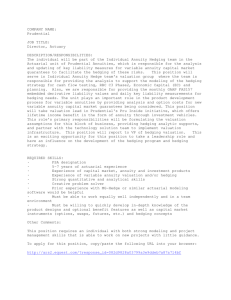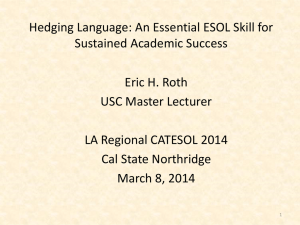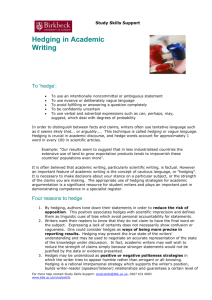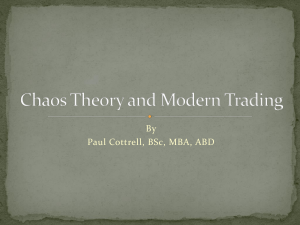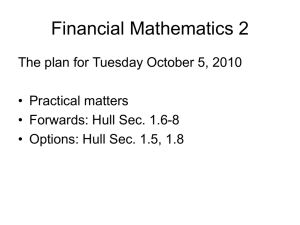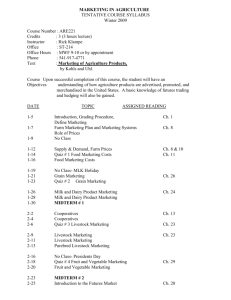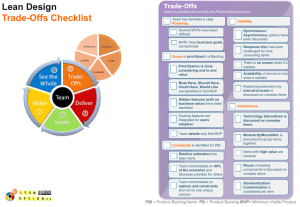Capacity and Production Managment in a single Product
advertisement
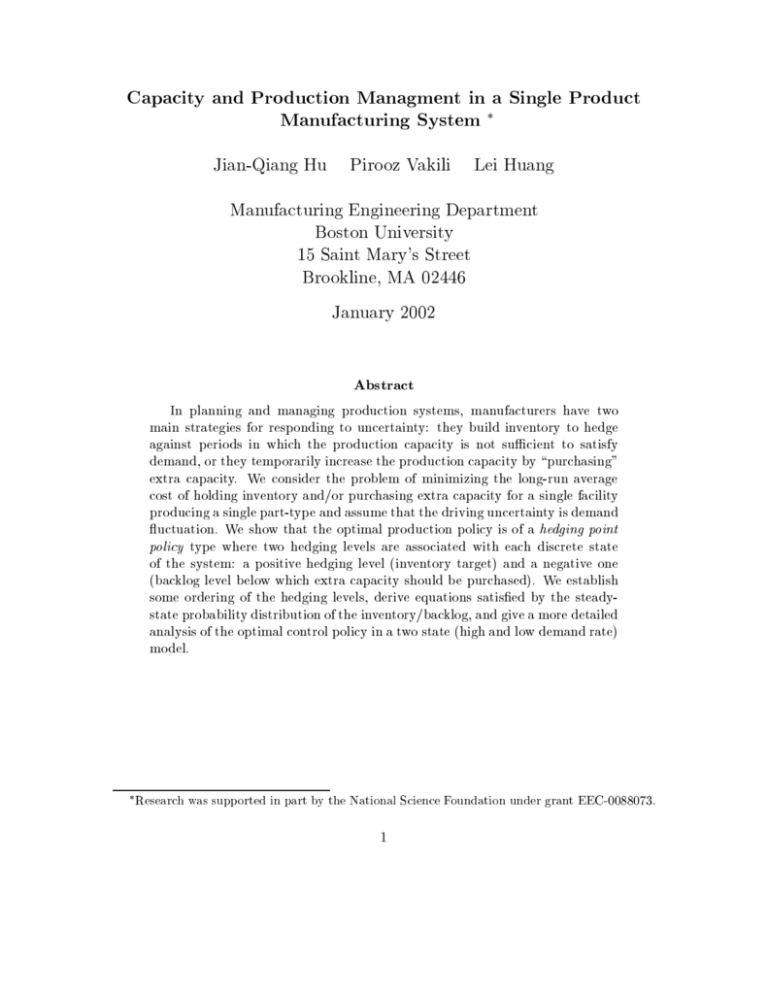
Capacity and Production Managment in a Single Product
Manufacturing System Jian-Qiang Hu
Pirooz Vakili
Lei Huang
Manufacturing Engineering Department
Boston University
15 Saint Mary's Street
Brookline, MA 02446
January 2002
Abstract
In planning and managing production systems, manufacturers have two
main strategies for responding to uncertainty: they build inventory to hedge
against periods in which the production capacity is not suÆcient to satisfy
demand, or they temporarily increase the production capacity by \purchasing"
extra capacity. We consider the problem of minimizing the long-run average
cost of holding inventory and/or purchasing extra capacity for a single facility
producing a single part-type and assume that the driving uncertainty is demand
uctuation. We show that the optimal production policy is of a hedging point
policy type where two hedging levels are associated with each discrete state
of the system: a positive hedging level (inventory target) and a negative one
(backlog level below which extra capacity should be purchased). We establish
some ordering of the hedging levels, derive equations satised by the steadystate probability distribution of the inventory/backlog, and give a more detailed
analysis of the optimal control policy in a two state (high and low demand rate)
model.
Research was supported in part by the National Science Foundation under grant EEC-0088073.
1
1
Introduction
In planning and operation of production systems manufacturers have two main strategies for responding to uncertainty: they build inventory to hedge against periods in
which the production capacity is not suÆcient to satisfy demand (high demand or
low capacity), or they temporarily increase the production capacity (for example, by
hiring temporary workers, adding overtime and extra shifts, or by outsourcing part
of the production). Each of these options has an associated cost and the task of a
production planner and manager is to strike a balance between them.
This problem can be formulated in the framework of ow control of manufacturing
systems where inventory/backlog of discrete parts is approximated by continuous
variables and the dynamics of the inventory/backlog by dierential equations; changes
in demand and production capacity are modeled by a discrete state stochastic process,
often a Markov chain. To focus the discussion and interpretation of the results, in
this paper, we assume that the driving uncertainty is random uctuation in demand.
An average default production capacity is assumed that in some states (high demand
states) is not suÆcient to satisfy the demand. However, there is always the option of
temporarily increasing the production capacity using one of the options mentioned
above. Therefore we distinguish between default and \extra" capacity. It is assumed
that using extra capacity induces a higher cost of production than using the default
capacity. Moreover, we assume that in all circumstances it is possible to match and
exceed the demand rate by using a combination of default and extra capacity. (This
is an assumption that separetes the model considered in this paper from most others
discussed in the literature). The problem therefore is the management of production
rate and the production capacity in order to satisfy demand while optimizing the
long-run average cost.
We consider the case of a single product and a single production facility. In this
case the structure of the optimal production policy has been derived (see, e.g., Sethi
et al. [8]; they do not directly consider this problem; however, their results, with some
modications, imply the structure of the controller in this case). The optimal production policy is of a hedging point policy type where two hedging levels are associated
with each discrete state of the system: a positive hedging level (inventory target)
and a negative one (backlog level below which extra capacity should be purchased).
Given this structure, the problem of specifying the optimal production control policy
2
becomes that of determining the optimal hedging points. We establish some ordering
of the hedging levels and derive equations satised by the steady-state probability distribution of the inventory/backlog. Finally, we discuss a two-state model (high and
low demand rates) in more detail and completely characterize the optimal control
policy.
Gershwin [2] and Sethi and Zhang [10] provide detailed reviews and comprehensive
lists of references on ow control of manufacturing systems. As mentioned above, most
models considered in the literature assume the existance of a discrete state at which
the production capacity is not suÆcient to satisfy demand and therefore, while the
system remains in this state, the backlog increases, possibly without bounds, see e.g.,
[11]. Allowing for an option to address this situation (e.g., purchasing extra capacity)
we provide some insight about what the optimal production control should be. A
similar problem without the possibility of purchasing extra capacity is addressed by
Sharifnia [11]. Hu and Xiang [4], [5], and Liberopoulos and Hu [6] derive similar order
relationship to what is established in this paper between hedging levels for the case
where purchase of extra capacity is not considered. Some of the results of Sethi et
al. [9], [8], and [7] are along the same lines. Purchase of extra capacity in an indirect
way is considered in Hu [3]. A more restricted case of the problem considered in this
paper is analyzed in Huang, Hu and Vakili [12] and the optimum hedging levels are
derived analytically.
The rest of the paper is organized as follows. Problem formulation is given in
Section 2; the optimal control policy is described in Section 3. Some ordering of the
hedging levels are derived in Section 4, and the equations satised by the steady-state
distribution are derived in Section 5. In Section 6, we give a detailed analysis of the
optimal control policy in a two-state (high and low demand rate) model.
2
Problem formulation
For presentational purposes we distinguish between general and special cases of the
problem. In the general case we make no explicit distinction between default and extra
capacity or between random uctuation of demand and that of production capacity.
In the special case we assume that only the demand rate is subject to random changes
and the capacity remains unchanged.
3
2.1 The general case
Let = f(t); t 0g denote a stochastic process representing all stochastic elements
present (random uctuation in demand or production capacity). Let x = fx(t); t > 0g
denote the surplus/backlog level. We assume that only one part type is produced, so
x(t) is a scalar. (x; ) = f(x(t); (t)); t 0g is then the state process of the system.
The production rate at time t is denoted by u(x; )(t) and the demand rate by
d (t). The dynamics of x(t) is given by
dx
(t) = u(x; )(t) d(t) :
dt
(1)
We assume that is a time-homogeneous irreducible Markov chain on the nite
set f1; ; mg; let = (ij ) denote the innitesimal generator of . We assume that
is not aected by the production control policy, i.e., is not a function of u. To
each stochastic state i 2 f1; ; mg there corresponds a capacity set [0; ai] and a
demand rate di. The key assumption in this paper is
Assumption A. At all time, i.e., in all stochastic states,
demand. Equivalently, di < ai for 1 i m.
it is possible to satisfy the
Let h(x) be the cost per unit time of holding x units of inventory or backlog, ci (u)
the cost per unit time of producing at rate u when the stochastic state is i. h(:) is
assumed to be a nonnegative convex function with h(0) = 0 and ci(:) a nonnegative
increasing function with ci(0) = 0.
Let denote a control policy belonging to an appropriately dened set of control
policies (measurable with respect to the process , satisfying capacity constraints,
and yielding a unique solution to the system dynamic equation). We dene the cost
associated with to be the long-run average cost:
1 ZT
J (x; i) = lim E [ (h(x) + c (u)dtjx(0) = x; (0) = i]:
(2)
T !1 T
0
An optimal control policy in this setting is a feasible control policy 2 that
yields the minimum cost:
J
J for all 2 :
4
(3)
2.2 The special case
In the special case we assume that only the demand rate is subject to random uctuation and the capacity set remains unchanged. The capacity set is assumed to consist
of two components: default capacity and extra capacity; we also assume that using
default capacity is less costly that using extra capacity. To make these assumptions
more explicit:
Let capacity set C = [0; r2] = [0; r1] S(r1; r2 ], (r1 < r2 ) where using a production
rate of u > r1 corresponds to using all of default capacity and in addition employing
u r1 of extra capacity.
The production cost function, c is given by
(
0 u r1
c(u) = cc1 uu + (c c )r
(4)
r1 < u r2
2
1 2 1
where 0 < c1 < c2.
Without loss of generality, we assume that the demand rates are given by
0 d1; ; dk < r1 < dk+1; ; dm < r2 :
In states f1; ; kg the default capacity is suÆcient to satisfy the demand, and in
states fk + 1; ; mg it is not. We call the later states the decit states.
3
Optimal control policy
The general case results stated below follow from the results of Sethi et al. [8]. The
only signicant dierence between the model considered in [8] and the general model
in the previous section is that in [8] it is assumed there exists at least one stochastic
state i at which the demand rate is higher than the production capacity. This assumption implies that, even under optimal control policy, the backlog may become
unboundedly large. As we will see, in our case, under optimal control policy, the
inventory/backlog state always remains within a bounded region (except possibly
during an initial transient period). This fact simplies some of the derivations in [8],
in particular, the proof of the stability of the inventory/backlog process under the
optimal control policy. We state the results related to the general case without proof.
Dene the dierential cost function Vi (x) (value functions for simplicity) by
5
1 ZT
Vi (x) = Tlim
E [ [h(x) + c (u) J ])dt j x(0) = x; (0) = i]:
!1 T
0
The HJB equation in this context is given by
X
minf dVi (x) (u d ) + V (x) + h(x) + c (u)
u
dx
i
j
ij j
i
J g = 0
(5)
(6)
The rst theorem states the existence of a solution to the HJB equation.
Theorem 1 There exists a solution (V ; J ) to the HJB equation where
J is unique in the sense that for any other pair (V 0 ; J 0) satisfying the HJB
equation, J = J 0 ;
Vi (x) is convex and continuously dierentiable.
The second theorem provides a verication theorem for an optimal policy characterized by the HJB equation.
Theorem 2 Let (V ; J ) be a solution to the HJB equation and assume there exists
a control policy u (:) such that
minf dV(t) (x (t)) (u d ) + c (u)g = (u(t) d ) dV(t) (x (t)) + c (u(t));
(t)
(t)
(t)
(t)
dx
dx
where x (:) is the invenorty/backlog associated with u (:), then J is the cost associated
with the control policy u (:) and furthermore, J is the optimal cost.
u
Given the above, it can be shown that the optimal control is dened as follows
(see [8], Section 5) (here we assume that ci(:) is twice continuously dierentiable for
all i = 1; ; m.)
8
x > zi
>
<0
(7)
u (x; i) = > dcdui 1 ( dVdxi (x))
zi0 x zi
:r
0
x zi
i
In the special case the optimal control policy is given by
8
>
>
>
<
0
minfdi; r1g
u (x; i) = > r1
>
maxfdi; r1g
>
:
r2
6
x > zi
x = zi
zi0 x zi
x = zi0
x < zi0
(8)
zi and zi0 are called upper and lower hedging points associated with the stochastic
state i and they are characterized as follows:
Lemma 1 zi is the minimizer of Vi (x)+ c1 x and zi0 is the minimizer of Vi (x)+ c2 x.
Proof. Vi(x) + c1x and Vi (x) + c2x are convex. The minimizers of these functions
are solutions to dVdxi (x) = c1 and dVdxi (x) = c2 . These dene zi and zi0 as can be seen
from the solution to the general problem.
From now on we focus on the special case model. In other words, we assume that
the capacity of the system remains unchanged and that it is partitioned into a default
and an extra capacity set. The next section provides some more information about
the optimal hedging points.
4
The order of optimal hedging points
The rst result establishes that all upper hedging points are non-negative and all
lower hedging points are non-positive. In other words, as long as there is inventory,
there is no need to purchase extra capacity.
Proposition 1 zi 0 zi0 , i = 1; ; m.
Proof. Note that for any i = 1; ; m and any x < zi0 the HJB equation can be
re-written as
=
X
dVi (x)
(
r2 di ) ( ij )(Vi (x) + c2 x) + c1 r1 + c2 (r2
dx
j 6=i
X
ij (Vj (x) + c2 x)
j 6=i
r1 ) + h(x) J (9)
Assume zi0 = maxfzj0 ; 1 j mg and assume zi0 > 0. Then, let x 2 (maxf0; zj0 ; j 6=
ig; zi0 ). On this interval the left hand of the above equation is a strictly increasing
function of x while the right hand side is a decreasing function of x (note that on this
interval Vj(x) + c2 x is increasing for all j 6= i). This is a contradiction. Therefore,
zi0 0 and hence all lower hedging points are non-positive.
The proof for zi 0 is similar with the dierence that the HJB equation is written
as
7
dVi (x)
( di )
dx
X
(
j 6=i
ij )Vi (x) + h(x) J =
X
j 6=i
ij Vj (x)
(10)
and the region x 2 (zi; minf0; zj ; j 6= ig) is considered.
P
Lemma 2 Let i be a non-decit state, Vsi (x) = j 6=i ij (Vj (x) + c1 x), and zsi
minimum of Vsi (x). Then
zi zsi maxfzj : j 6= i and ij 6= 0g:
the
Proof. Since ij 's are all positive and Vj(x) + c1x's are convex, Vsi (x) is convex, and
zsi is well-dened. Furthermore, clearly,
0 minfzj : j 6= i and ij 6= 0g zsi maxfzj : j 6= i and ij 6= 0g:
Let x 2 (0; zi), then the HJB equation can be written as:
X
dVi (x)
(r d ) ( )(V (x) + c x) + h(x) + c r J = V (x):
dx
1
i
j 6=i
ij
1
i
1 1
si
is a non-decit state, therefore, r1 di > 0 and the left-hand side of the above
equation is increasing in x over the interval (0; zi). This implies that the right-hand
side of the equation is increasing and hence Vsi (x) is decreasing over (0; zi).
This implies that
zi zsi maxfzj : j 6= i and ij 6= 0g:
P
Lemma 3 Let i be a decit state, Vs0i (x) = j 6=i ij (Vj (x) + c2 x), and zs0 i the minimum of Vs0i (x). Then
minfzj0 : j 6= i and ij 6= 0g zs0 i zi0 :
Proof. Since ij 's are all positive and Vj0 (x)+ c2x's are convex, Vs0i (x) is convex, andzs0 i
is well-dened. Furthermore, clearly,
minfzj0 : j 6= i and ij 6= 0g zs0 i maxfzj0 : j 6= i and ij 6= 0g 0:
Over the interval (zi0 ; 0) the HJB equation can be written as
X
dVi (x)
(r d ) ( )(V (x) + c x) + h(x) + c r J = V 0 (x):
i
dx
1
i
j 6=i
ij
2
i
8
1 1
si
i is a decit state, therefore, r1 di < 0 and the left-hand side of the above equation
is decreasing in x over the interval (zi0 ; 0). This implies that the right-hand side of
the equation is decreasing and hence Vsi (x) is increasing over (zi0 ; 0).
This implies that
minfzj0 : j 6= i and ij 6= 0g zs0 i zi0 :
Now let us make a further assumption that the demand process forms a birthdeath process. Recall the assumption that
0 d1; dk < r1 < dk+1; ; dm < r2:
Assume further that ij = 0 for jj ij 2, and ij 6= 0 otherwise. Then the
following order exists between hedging points
Proposition 2 If the demand process follows a birth-death process as dened above,
we have:
zk0 +1 zk0 +2 zm0 1 zm0 0 z1 z2 zk 1 zk :
Proof. Start at state 1 (a non-decit state). By Lemma 2
z1 zs maxfz2 g = z2 :
Next considering state 2; we have
z2 zs maxfz1 ; z3 g = z3 :
Using a similar argument, by induction, we have
0 z1 z2 zk 1 zk :
For decit states k + 1; ; m, we start at m
zm0 zs0 m minfzm0 1 g = zm0 1 :
Next consider state m 1, we have
zm0 1 zs0 m minfzm0 ; zm0 2 g = zm0 2 :
Using a similar argument, by induction, we have
zk0 +1 zk0 +2 zm0 1 zm0 0:
This completes our proof.
1
2
1
9
Remark 1 Note that applying the above approach to the two \boundary states" k
and k + 1 we also nd that
and
5
zk+1 zk
zk0 zk0 +1 :
Steady state probability distribution of (x; )
Given that the optimal control policy is a hedging point policy as dened in the previous sections, determining the optimal control is equivalent to determining the optimal
hedging levels. To this end we desribe an approach to calculating the optimal cost
function as a function of a tentative set of hedging levels z1 ; ; zk and zk0 +1; ; zm0 .
Optimzing the cost function with respect to z = (z1; ; zk ; zk0 +1; ; zm0 ) yields the
optimal control policy.
5.1 Probability ow balance equations
The steady state probability distribution of the invenory/backlog is needed to compute the average cost of the proposed control policy. We begin by deriving the joint
probability distribution of the inventory/backlog level and the demand state (x; )
by presuming a particular order among all non-transient hedging points.
Assume that x(0) = 0. Then the trajectory of the inventory/backlog remains
within [zk0 +1; ; zk ] at all times. We consider a partition of this interval (minus the
hedging levels) into m + 1 region as follows
Ri = fx : zi < x < zi+1 g i = 1; ; k 1
S = fx : zm0 < x < z1 g;
Qi = fx : zi0 < x < zi0+1 g i = K + 1; ; m 1:
Let
P t (x; j ) = ProbfX (t) x; (t) = j g;
and the instantaneous net production rate be
ij = rij dj ; x 2 Ri ; Qi; or S:
where rji = 0; r1; or r2, as dened by the control policy and i; j = 1; ; m.
10
Then, we have the following set of balance equations:
P t+t (x; l) =
X
j 6=l
jl P t (x
ji t; j ) + (1 + ll t)P t (x ji t; l) + o(t):
Assume that the steady state probability distribution exist, that is: P (x; l) =
limt!1 P t(x; l); l = 1; 2; ; m. Then by rearranging and letting t ! 1 and t ! 0,
we have
m
X
j dP (x; l) = P (x; j )
i
dx
j =1
jl
Or, in matrix notation,
dP (x)
= P (x)Ai
dx
Where: x 2 Ri, Qi, S , = (jl), j; l = 1; 2; ; m,
P (x) = [P (x; 1); P (x; 2); ; P (x; m)], and Ai = i 1 .
i =
diag [1i ; 2i ; ; mi ],
The probability distribution function is right-continuous and has jumps at hedging
levels with nonzero probability mass.
5.2 Boundary conditions
Let the probability mass at zi and zi0 be denoted by p(zi ) = Probfx = zi g; for
i = 1; ; k and p(zi0 ) = Probfx = zi0 g for i = k + 1; ; m. Also let
P (zi )
P
= Ælim
P (zi + Æ )
!0
0
(zi0 ) = Ælim
P (zi + Æ )
!0
At the highest hedging level, zk , we have the rst set of boundary equations:
P (zk ; j ) = j
j = 1; ; m;
where j is the steady state probability of being in stochastic state state j and can be
calculated from = 0: and P j = 1: Moreover, at the lowest hedging level, zk0 +1,
we have
P (zk0 +1 ; j ) = 0; j = 1; ; m:
In addition we have
P (zi ) P (zi ) = p(zi )ei i = 1; ; k
11
and
P (zj0 ) P (zj0 ) = p(zj0 )ej j = k + 1; ; m
where ei is the row vector with m zero entries except with 1 at ith entry.
The above equations and the boundary conditions can be used to solve for P (:; j )'s
(including probability masses at zi's and zi0 's. Note that in our context we have exactly
the right number of equations to solve for all unknowns.
6
A Two-state (high and low demand rate) case
In this section, we consider m = 2. In other words, we assume that there are only
two stochastic demand states, 1 and 2, and
0 < d1 < r1 < d2:
Results of Section 4 imply that
z10 z20 z1 z2 :
In this case, once the state of the system is within the interval [z20 ; z1 ], it remains in
this interval forever. Hence, we only need to nd the optimal values for z1 and z20 .
For ease of exposition, we assume that c1 = 0 (i.e., there is no cost when using the
default capacity) and h(x) = c+x+ + c x . These assumptions are not essential and
the results presented in this section can be extended to more general settings.
We begin by identifying dierent cases for optimal hedging points (i.e., when they
are and when there not zero). Along the way we also determine the optimal cost and
optimal hedging levels (implicitly in some cases). These results can be derived using
the same approach as in [12].
1. For case z1 > 0 and z20 < 0.
d r
c+ z1 + c+ 2 1
12 + 21
= c ( z20 ) + c r1 + d1 + c2(d2 r1 21 (d+2 d1 ) );
12
21
12
21
0
where z1 > 0 and z2 < 0 are two uniques roots of the following two functions,
J
=
respetively,
f1 (z ) =
c+ e
0 z
+c
e
0
c (k
c+ z )
12
(d2
(d2
d1 )21
(c+ + c );
r1 )(12 + 21 )
f2 (z )
=
c+ e
where
=
0
=
k
=
0 (k c z)
c+
+c
e
0 z
21 (r1 d1 )
;
12 (d2 r1 )
12
21
;
r1 d1 d2 " r1
(d2 r1 )12 c
12 + 21
21
(d2
(d2
c2
d1 )21
(c+ + c );
r1 )(12 + 21 )
!
c+
12
c2
!#
:
Furthermore, f1(z) has a positive root and f2(z) has a negative root if and only
if f1 (0) < 0 and f2(0) < 0.
2. For case z1 = 0 and z20 < 0.
r d
21 (d2 d1 )
);
J = c ( z20 ) + c 1 1 + c2 (d2 r1
12 + 21
12 + 21
where z20 < 0 is the unique root of the following function:
c
(d r )(r d ) c c );
f3 (z ) = c z +
(
e z 1) + 2 1 1 1 0 (
0
12 + 21
21 2
and f3(z) has a negative root if and only if c2 > c =21 .
3. For case z1 > 0 and z20 = 0.
0
d r
J = c+ z1 + c+ 2 1 ;
12 + 21
where z1 > 0 is the unique root of the following function:
c+ z
(d2 r1)(r1 d1 ) ( c+
(
e
1)
+
f4 (z ) = c+ z +
0 0
12 + 21
12
and f4(z) has a positive root if and only if c2 > c+=12 .
4. For case z1 = 0 and z20 = 0.
c (d r )
J = 2 2 1 12 :
12 + 21
0
13
c2 );
6.1 Comparison with no-extra capacity case
When the extra capacity is not available (i.e., r2 = r1), for the system to be stable,
it is required that 21 (r1 d1) 12(d2 r1) > 0, which implies 0 < 0 and > 1.
Under this stability condition, it can be shown that the optimal control is the following
hedging point policy (e.g., see [1])
8
>
< 0 x>z
z
u = (x; i) = > d1 x = z
(11)
:
r1 x < z
where
z=
(
1
0
log
h (d
d1 )12 (c+ +c )
c (r1 d1 )(12 +21 )
2
+
0
and the optimal cost is given by
8 +
< c z + c+ d +r
J =
i
if c(d (r d d))((c ++c )) 1
otherwise
1
+
2
1
12
1
+
12
(12)
21
if z > 0,
(13)
:
otherwise.
In what follows, we compare the optimal hedge points z1 and z as well as the
optimal costs J and J0 . To simplify our derivation, we focus exclusively on z20 < 0,
i.e., Cases 1 and 2. We rst consider z = 0. In this case, (d2 d1)12 (c+ + c ) <
c+ (r1 d1 )(12 + 21 ), hence
k
(d2 d1)21
f1 (0) = c+ + c e c
" + (d2 r1 )(12 + 21 )+
#
k
c (r1 d1 ) (d2 d1 )(c + c )
21
+
c e c > 0:
= (d r )
+
2
1
;
c 12 (d2 d1 )(d2 r1 )
(12 +21 )(21 (r1 d1 ) 12 (d2 r1 )) ;
0
12
21
0
0
2
1
12
12
21
Since f1(0) > 0, Case 1 is not possible (which requires f1(0) < 0 and f2 (0) < 0), i.e.,
z = 0 implies z1 = 0 (and z20 < 0). This, combined with condition f3 (z20 ) = 0, leads
to
c 12 (d2 r1 )2
c
0
+
(1
e z ) 0:
J0 J =
21 (21 (r1 d1 ) 12 (d2 r1 )) 0
We now consider z > 0. There are two corresponding cases to consider: 1) z1 > 0
and 2) z1 = 0. If z1 > 0, then it is the unique positive root of f1 (z), i.e., f1(z) = 0,
based on which we have
(d2 d1)12(c+ + c ) e z
c+ (r1 d1 )(12 + 21 )
0 2
0 1
14
+
= c(+d2(r d1d))(12(c ++c )) + c e
1
1 12
21
(
d2 d1 )12 c
= c+(r d )( + ) + c e
1
1 12
21
> 0:
0
c (k
c+ z )
0
c (k
c+ z )
(d2
(d2
d1 )21
(c+ + c
r1 )(12 + 21 )
)
It then immediately follows that z > z1 and J0 J = c+(z z1 ) > 0. If z1 = 0,
obviously, z > z1 , and we also have
(d r ) (d2 r1)2 d2V1(0+) ;
J = c+ 2 1
12 + 21 12 + 21 dx2
where V1(x) the optimal dierential cost function at = 1 (see [12, Section 4.2]).
Since V1(x) is convex, we have
(d r )2 d2V1 (0+) > 0:
J0 J = c+ z + 2 1
12 + 21 dx2
To summarize, we give
Proposition 3 If z20 < 0, then z z1 and J0 J .
We believe that the result in Proposition 3 should hold for z20 = 0 as well. However,
its derivation would be much more involved and many detailed results derived in [12]
would be needed. Theorem 3 essentially states that by using extra capacity (at any
cost) one can reduce the hedging point level as well as the total cost. Intuitively, it
is quite clear since one can think that the optimal control policy for the case without
extra capacity is also a special control policy for the case with extra capacity in which
the extra capacity is never used.
If one has to pay for the option of having the extra capacity available, then the
average price (per time unit) for such an option should not exceed J0 J . Also, note
that in the optimal control policy the amount of extra capacity used never exceeds d.
Therefore, one only needs to buy an option with d units of extra capacity.
References
[1] T. Bielecki and P.R. Kumar, \Optimality of Zero-Inventory Policies for Unreliable
Manufacturing Systems," Operations Research, Vol. 36, No. 4, pp. 532-541, JulyAugust 1988.
15
[2] S. Gershwin, Manufacturing Systems Engineering, Prentice Hall, 1994.
[3] J.Q. Hu, \Production Rate Control for Failure Prone Production With No Backlog
Permitted," IEEE Transactions on Automatic Control, Vol.40, No.2, pp. 291-295,
1995.
[4] J.Q. Hu and D. Xiang, \Structure Properties of Optimal Production Controllers
of Failure Prone Manufacturing Systems," IEEE Transactions on Automatic Control, Vol.39, No.3, pp. 640-643, 1994.
[5] J.Q. Hu and D. Xiang, \Monotonicity of Optimal Flow Control for Failure Prone
Production Systems," Journal of Optimization Theory and Applications, Vol. 86,
No.1, pp. 57-71, July 1995.
[6] G. Liberopoupos and J.Q. Hu, \On the Order of Optimal Hedging Points in a
Class of Manufacturing Flow Control Models," IEEE Transactions on Automatic
Control, Vol.40, No.2, pp. 282-286, 1995.
[7] Sethi, S. P. Yan, H. Zhang, H. and Zhang, Q. \Turnpike Set Analysis in Stochastic Manufacturing Systems with Long-Run Average Cost," in Optimal Control and
Partial Dierential Equations in Honour of Professor Alain Bensoussans 60th
Birthday, J.L. Menaldi, E. Rofman, and A. Sulem (Eds.), IOS Press, Amsterdam,
pp. 414-423, 2001.
[8] Sethi, S. P. Suo, W. Taksar, M. I. and Zhang, Q. \Optimal Production Planning
in a Stochastic Manufacturing System with Long-Run Average Cost," JOTA, Vol.
92, 1, pp. 161-188, 1997.
[9] S. Sethi, H.M. Soner, Q. Zhang, and J. Jiang, \Turnpike Sets and their Analysis
in Stochastic Production Planning Problems," Math. OR, Vol. 17, pp. 932{950,
1992.
[10] S.P. Sethi and Q. Zhang, Hierarchical Decision Making in Stochastic Manufacturing Systems, Birkhauser, Boston, 1994.
[11] A. Sharifnia, \Optimal Production Control of a Manufacturing System with
Machine Failures," IEEE Transactions on Automatic Control, Vol. AC-33, No. 7,
pp. 620-625, July 1988.
16
[12] L. Huang, J.Q. Hu, P. Vakili, "Optimal control of failure prone production system with the possibility of using extra capacity", in "Recent Advances in Manufacuturing Engineering" G. Yin and Q. Zhang Eds. pp. 31-60, Springer-Verlag.
1996.
17

